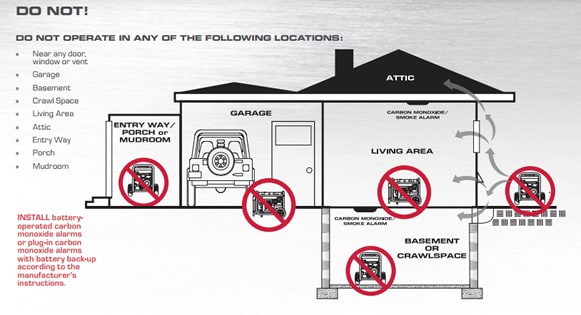
Electric Generator Safety
How to Use a Generator and Stay Safe
I recently visited a friend. The power happened to go out on his block that day, and he was working in his garage. As I approached, I could hear a generator but couldn't see it outside the house. When I got up close, I realized why.
It was running in his garage. My friend was lucky I didn't find him passed out on the floor from the carbon monoxide (CO) emissions.
Generator safety should be in every owner's blood before flipping the on-switch. Remember, you are dealing with a machine that uses flammable fuel to generate serious volts of electricity and releases deadly carbon monoxide gas.
There are a lot of ways you can incorrectly and unsafely operate a generator. Here is what to keep in mind to keep you and your family safe.
Beware of Carbon Monoxide
Do not run generators inside homes, garages, crawlspaces, basements, sheds, or similar areas, even when using fans or opening doors and windows for ventilation.

Deadly levels of CO can quickly build up in these spaces and can linger for hours, even after the generator has shut off.
Install and maintain battery-operated CO alarms or plug-in CO alarms with battery backup in your home, according to the manufacturer's instructions. CO alarms should be certified to the requirements of the latest safety standards (UL 2034, IAS 6-96, or CSA 6.19.01).
Test batteries monthly. Smoke alarms cannot detect CO.
Get Fresh Air if Dizzy
Get to fresh air right away if you start to feel dizzy or weak.
Beware of Flammable Vapors
Gasoline and its vapors are extremely flammable. Before refueling the generator, turn it off and let it cool down at least 2 minutes before removing the fuel cap. Gasoline spilled on hot engine parts could ignite. Never add gasoline to a hot or running portable generator.
If gasoline spills, wait until it evaporates before starting the engine. Always use fresh gas in your generator. If you do not plan to use your generator in 30 days, stabilize the gas with fuel stabilizer.
Do Not Store Fuel in Your Home
Never store fuel for your generator in the home. Gasoline, propane, kerosene, and other flammable liquids should be stored outside of living areas in properly-labeled, non-glass safety containers.
Do not store them near a fuel-burning appliance, such as a natural gas water heater in a garage.
Follow the Instructions
Follow the manufacturer's operating and maintenance instructions that accompany your generator before operating.
Place the generator outside, far from doors, windows, vents and other openings that could allow CO to come indoors or be drawn into potentially occupied spaces. Direct the engine exhaust down-wind and away from potentially occupied spaces.
Leave Space Around the Generator
To reduce the risk of fire, keep at least 5 feet of clearance on all sides of the generator, including overhead. DO NOT operate the generator near combustible materials.
Don't Operate in the Rain
Generators pose a risk of shock and electrocution, especially if they are operated in wet conditions. Wait for the rain to pass before using a generator.
If you must use a generator when it is wet outside, protect the generator from moisture to help reduce the risk of shock or electrocution, but do so without operating the generator indoors or near openings.
Operate the generator under an open, canopy-like structure on a dry surface where water cannot reach it or puddle or drain under it. Dry your hands, if wet, before touching the generator.
Use Long, Heavy-Duty Cords
Connect appliances to the generator using heavy-duty extension cords that are specifically designed for outdoor use. Make sure the wattage rating for each cord exceeds the total wattage of all appliances connected to it.
Use extension cords that are long enough to allow the generator to be placed outdoors and far away from windows, doors, and vents to the home or to other structures that could be occupied.
Protect the cord from getting pinched or crushed. Coiled cords can get hot, always uncoil cords and lay them in flat open locations.
Never Back Feed
Never try to power the house wiring by plugging the generator into a wall outlet, a practice known as "back feeding."
Back-feeding is extremely dangerous and presents an electrocution risk to utility workers and neighbors served by the same utility transformer. It also bypasses some of the built-in household circuit protection devices.
If you are connecting a generator to your home electrical system, have a qualified electrician install a power transfer switch.
CO Detectors
There are portable generators available today that have the best possible protection against carbon monoxide poisoning - a CO detector.
These built-in detectors automatically shut the portable generator's engine off when they detect dangerous levels of CO surrounding the unit, providing safety and peace-of-mind.
Be Safe
Following these precautions and using common sense will ensure that your generator is extremely safe to use. Like with anything else, put safety first.
*Information Courtesy of Briggs & Stratton Corporation, 2012

